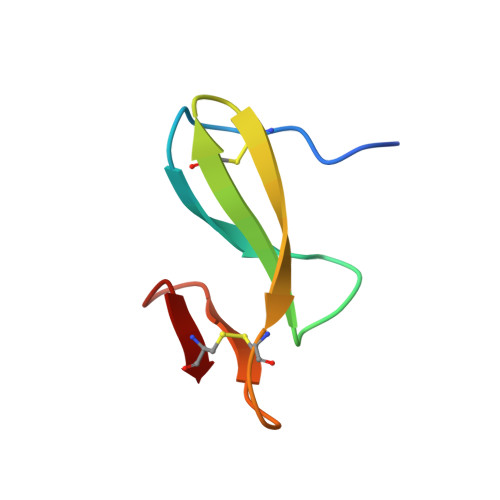Serological, genomic and structural analyses of the major mite allergen Der p 23.
Mueller, G.A., Randall, T.A., Glesner, J., Pedersen, L.C., Perera, L., Edwards, L.L., DeRose, E.F., Chapman, M.D., London, R.E., Pomes, A.(2016) Clin Exp Allergy 46: 365-376
- PubMed: 26602749
- DOI: https://doi.org/10.1111/cea.12680
- Primary Citation of Related Structures:
4ZCE - PubMed Abstract:
Der p 23 was recently identified in a European population as a major allergen and potentially a chitin binding protein. This study sought to assess the importance of Der p 23 among other Dermatophagoides allergens in a North American population and to determine the structure for functional characterization. IgE binding to Der p 23, Der p 1, Der p 2, Der p 5, Der p 7 and Der p 8 was measured by ELISA. RNA-seq data from D. pteronyssinus were compared as estimates of allergen expression levels. The structure was analysed by X-ray crystallography and NMR. Despite a high prevalence of Der p 23, (75% vs. 87% and 79% for Der p 1 and Der p 2, respectively), the anti-Der p 23 IgE levels were relatively low. The patient response to the 6 allergens tested was variable (n = 47), but on average anti-Der p 1 and anti-Der p 2 together accounted for 85% of the specific IgE. In terms of abundance, the RNA expression level of Der p 23 is the lowest of the major allergens, thirty fold less than Der p 1 and sevenfold less than Der p 2. The structure of Der p 23 is a small, globular protein stabilized by two disulphide bonds, which is structurally related to allergens such as Blo t 12 that contain carbohydrate binding domains that bind chitin. Functional assays failed to confirm chitin binding by Der p 23. Der p 23 accounts for a small percentage of the IgE response to mite allergens, which is dominated by Der p 1 and Der p 2. The prevalence and amount of specific IgE to Der p 23 and Der p 2 are disproportionately high compared to the expression of other Dermatophagoides allergens.
- Genome Integrity and Structural Biology Laboratory, Research Triangle Park, NC, USA.
Organizational Affiliation:

















